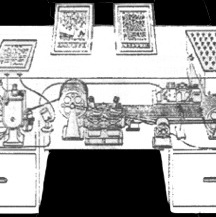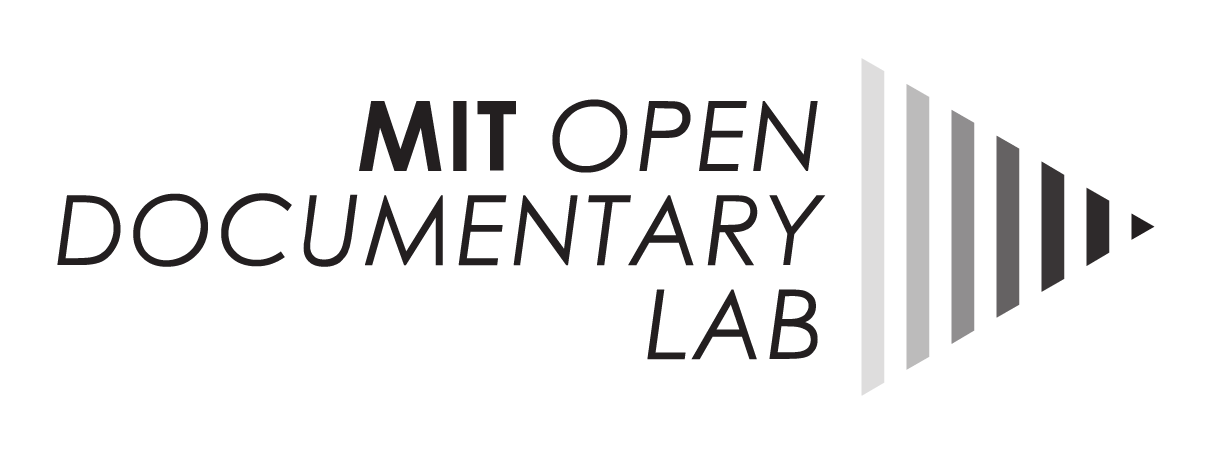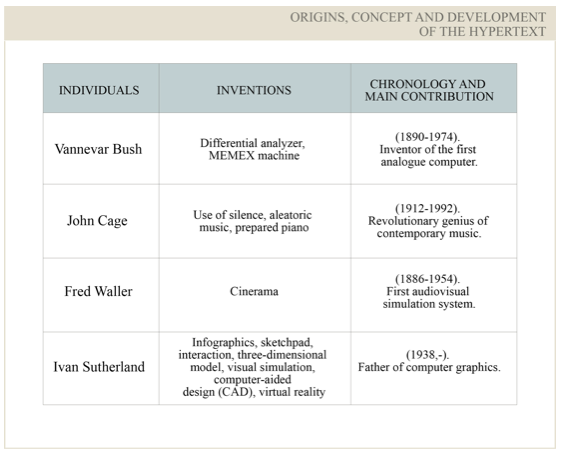
17 Jul Research Forum | Arnau Gifreu Castells on Documentaries and Digital Media, Part 4
The Open Documentary Lab is pleased to announce the Research Forum, a space for researchers to voice their opinions and test new theories. As part of our mission to promote the exchange of ideas about the new arts of documentary, we hope to encourage academic discussion and debate about these emerging forms by creating a place where researchers can develop ideas and interact with the field. The views presented here belong to their authors, and will necessarily take different forms. In the spirit of the documentaries we study, we look forward to community collaboration and exchange as the ideas explored in the Research Forum take root, grow and support the development of the field.
Combined evolution of the documentary genre and interactive media: towards the interactive documentary
Introduction: the documentary genre and the digital media (IV)
by Arnau Gifreu Castells
In this series we focus on analyzing the two main parts that constitute the interactive documentary field: the documentary genre and interactive media. In these articles we introduce an original combined evolution of the digital and documentary mediums, in which it is interesting to observe that there are some significant coincidences in time between them. Our aim is to link moments of innovation in the documentary genre and storytelling in general with technological experiments, inventions and pioneering concepts in the digital field.
Proposed types of documentary
Despite the difficulties and differences in the proposals for classification of the documentary, the various efforts are in themselves an interesting methodological tool for the study of documentary and its discourse. The aim of this section is to present the most widely accepted and recognized classifications within the academia of the documentary.
Since the 1980s, and especially in recent years, there has been a strong new conceptual movement in non-fiction film, which has replaced or reworked many previous concepts and practices. There are various theoretical trends, such as the semiological and psychoanalytic model, represented by William Guynn; anthropological theory and information, represented by Bill Nichols; deconstructionism and postmodernism, as in the ideas of Michael Reno; feminism and postcolonialism, represented by Trinh T. Minh-Ha, and critical realism and cognitivism (“post-theory”) as considered by Noël Carroll and Carl Plantinga. In this section, we discuss in depth the classifications of Erik Barnouw, Michael Renov and Bill Nichols, in order to classify the periods, movements, authors and works with the various proposals presented by the authors. For reasons of space, we will omit other authors from our study, such as Peter I. Crawford (Crawford 1992) and Elisenda Ardèvol (Ardèvol 1995 and 1996), whose proposals are included in a final synoptic table (Table 1).
Barnouw and the historical modes
In his book published in 1996, Documentary. A History of the Non-Fiction Film, Erik Barnouw categorizes movements and series of films with similar stylistic characteristics and which fulfill the same social function, and which take place at a specific historical point. The common link in his classification is based on a particular profession or trade.
Barnouw’s work begins with a brief description of the background and history that made the invention of cinema possible. He begins by focusing his attention on Louis Lumière, who he describes as a prophet (the invention of the Lumière brothers anticipated and prophesied immense future possibilities). One of the first pioneers to take advantage of the Lumières’ new invention was Robert Flaherty, in a kind of anthropological and ethnographic documentary, described by Barnouw as an explorer (based on the financed expeditions of the period, which enabled the production of the first film in the genre); he then examines the role of the reporter (the news genre, following the guidelines laid down by the Soviet propaganda of the time), with one name in particular, Dziga Vertov. This is followed by the avant-garde and its innovative contribution to the genre, described by Barnouw using the figure of the painter (documentary filmmakers had very artistic and pictorial, as is apparent in their output) and emphasizing authors such as Walter Ruttman, Jean Vigo and Joris Ivens. The documentary then adopted the role of an advocate (the documentary within a social context, to defend the cause of the people and society), in which the central figure of Grierson and the British school assumed a prominent role. In preparation for the Second World War, he gives us the chapter discussing the bugler (in which the author presents clear examples of the·propaganda films of World War II), the exponents of which are Humphrey Jennings and Frank Capra. After the war, we look at the Thorndikes, who feature in the chapter on the prosecutor (who judges and condemns the war crimes of the Second World War) and the figure of the poet (characterized by a search for metaphorical, everyday or neorealistic language), a chapter featuring Arne Sucksdorf and Bert Haanstra. Towards the end of the book, the documentary is considered from the point of view of the chronicler (based on the historical account of the late fifties and early sixties), with Jean Rouch, and reaches the figure of the promoter (when works are sponsored by private institutions and companies), with Edward Murrow, among others. Fred Wiseman and Richard Leacock illustrate the chapter on the documentary observer (focused on the American direct cinema U.S.), followed by Chris Marker and the documentary as a catalyst (which breaks down and describes the French Cinema Verite), the guerilla (the showing of political and militant documentaries of the sixties and seventies) and video production focusing on the figure of John Alpert. By way of a conclusion, it features a lengthy closing chapter, the movement (which covers the heterogeneous documentary of the eighties and nineties). The latest trends are not included since it was published in 2001.
Renov and the modes of desire.
Michael Renov and Brian Winston adopt a deconstructive approach to the documentary. Winston reflects on scientific and documentary discourse, and concludes that the former has been invoked to legitimize the latter, and to become its standard. Renov (1993:2-3) believes that the terms of the established hierarchy between fiction and nonfiction must be displaced and transformed. “Nonfiction” is valuable as a category, but based on the assumption that it must necessarily include elements of fiction and vice versa.
Renov says that a perspective that assumes that the documentary is a completely sober discourse fails to understand the deep roots of non-fiction, because it is its distinctive historical status of which distinguishes the documentary from its fictional counterparts, and not its formal relationships. He concludes by saying that “the documentary shares the status of all discursive forms with regard to its tropical or figurative character,” and following other contemporary authors, he says that all forms of discourse, including the documentary, are at least fictitious if they are not fictional (Renov, 1993: 8).
Michael Renov (1993) uses the theory of poetry for his classification, which is an area that is far removed from that Barnouw, the historiographer. Renov proposes a division based on the specific process of composition, function and effect, based on four fundamental trends or aesthetic and rhetorical functions, which he says are modes of desire, which have been the mainstay of the discourse on the documentary for decades. They are as follows:
1. To record, reveal or preserve. This mimetic function is common to all film, and very closely associated with the documentary genre. This category could include anthropological or ethnographic documentaries (mainly represented by Robert Flaherty) and even personal diaries.
2. To persuade or promote. A function considered rhetorical by Renov, i.e. the search for aesthetic and argumentative techniques of persuasion to achieve social and personal goals. Examples include the British school and the Grierson-style documentary, but could also include Night and Fog, by Alain Resnais, because for Renov persuasion is a technique that cuts across through all the other functions.
3. To analyze or interrogate. A mimetic and rational function that is a more “cerebral” reflex than the first mode, in which the aesthetic attitude seeks the active involvement of the audience. This model includes the documentaries produced by the Direct Cinema and Cinéma Vérité schools, although this function was also found in pioneering documentaries, such as those by the Russian Dziga Vertov, or contemporary documentarists such as Alain Resnais and Chris Marker.
4. To express. This is the aesthetic function, closely related to the documentary form, of reality itself, but it has to date been the least highly valued and rejected because of the prevailing scientific attitude in society. The aesthetic function is predominant in many schools, such as the avant-garde, when the documentary is similar to pictorial arts or poetry, or Robert Flaherty’s anthropological documentaries.
Renov acknowledges that these methods are not specific to the documentary, or exclusive of anything that is not a documentary, but he argues that they bear witness to the historical richness and variety of forms of non-fiction in the visual arts and its rhetorical possibilities.
Hypertext: origins, concepts and development
Origin and development of the concept of hypertext
In his 1945 article “As we may think,” Vannevar Bush first introduced the crucial idea of hypertext: his imaginary system, “Memex “ was based on a nonlinear structure of documents, equivalent to the associative nature of the human spirit, with interesting added capabilities for exploring and recording textual or graphical information . Twenty years later, Douglas Engelbart made the first serious proposal for the implementation of Bush’s ideas. His basic idea was to use a computer in the manipulation of information, to achieve a real improvement of human intellectual capacities that would affect their working environment, with the full inclusion of the hypertext system (Ribas, 2000:35).
During the 1960s, Douglas Engelbart and Ted Nelson developed a program that was able to implement the concepts of hypertext and hypermedia. After the invention of the first personal computers in the 1980s, IBM launched the guide and link system for its computers, while Mackintosh developed the “Intermedia” and “HyperCard.”
The term hypertext was coined by Ted Nelson in the article No More Teacher’s Dirty Looks (Nelson, 1970), to refer to a system in which text, voice, images and video are able to interact with readers. As well as inventing the terms hypertext – for any piece of non-linear writing – and hypermedia, Nelson also devoted many years to building “Xanadu,” a type of “complete universal library” that was a forerunner of the Internet, which enabled people to link up and collaborate all over the world using text, images and sound. He was the first to think in terms of functionalities or ideas that are today included as a matter of course, such as being able to look at the “history” of a document modified by several authors, guaranteeing their rights, or being able to link a document to all of those that are related to it in the same work context. The basic original idea of hypertext affected the means of accessing information, through it, freely, but consciously.
The definition of hypertext
According to Ribas (2000:36), hypertext can be defined as “a network of interconnected pieces of textual information.” Hypertext can therefore be defined as a system for organizing information based on the ability to move around within a text and visit different texts by means of keywords.
Its basic components are called nodes. These are the basic and atomic documents within the network. The criterion for this atomic differentiation is the meaning. Nodes are semantic units: each node expresses a single idea or concept from the point of characteristic view of the content. Links are the parts of the network interconnecting the nodes and allowing the user to move node to node. There is usually a small portion of the source node to which the link is connected. This small part, which could be a word, a phrase, or a part of the image, is called the link’s anchor (Ribas, 2000:37).
The origin of the concept dates back to Theodor H. Nelson, who in the 1960’s proposed a possible system of “non-sequential writing, text that branches and allows choices to the reader” which he called hypertext (Nelson, 1981:2 and 1997:12). However, it was not consolidated until the mid-1980s, when personal computers began to have enough capacity to operate with small hypertext systems (Moulthrop, 2003:24). As Nelson says:
By ‘hypertext’, I mean non-sequential writing – text that branches and allows choices to the reader, best read at an interactive screen. As popularly conceived, this is a series of text chunks connected by links which offer the reader different pathways. (Nelson, 1981:1-2)
Landow (2005:25) adds that hypertext denotes “text composed of blocks of text – what Barthes terms a lexia – and the electronic links that join them.”
And in Hyper/Text/Theory (1995), he alludes to the comments of the linguist and professor Geoffrey Nunberg in his book The Future of the Book (1998):
The electronic link, the defining factor in this new information technology, produces multilinear or multisequential – not nonlinear – reading. By permitting readers to choose their ways through a particular set of lexias, hypertext in essence shifts some of the author’s power to readers. (Nunberg, 1998:230)
Maria Jose Vega, in her book Literatura hipertextual y teoría literáriia [Hypertext literature and literary theory] (2003), provides one of the most recent definitions of the concept of hypertext, in which she stresses that it is “a network of reemissions without a beginning or end”:
(Hypertext) consists of text and links that can be opened or activated to send to other texts (or to other types of visual or auditory information) [or nodes], which, in turn, contain links that refer to further texts [or nodes], and so on. In theory, the network of reemissions has no beginning or end: each hypertext aims to make it possible to continue reading another or other hypertexts, which in turn are linked to others, and so on ad infinitum. Links do not only relate different texts to each other, but also texts and other non-verbal media. (Vega, 2003: 9)
Stuart Moulthrop, in the chapter In the Zones: Hypertext and the Politics of Interpretation [El hipertexto y la política de la interpretación] in Vega’s book (2003), proposes a definition of hypertext based on the central concept of an “encyclopedia”, but without a definite structure:
A hypertext is in some ways like an encyclopedia, a collection of writings through which the reader is free to move in almost any sequence. But unlike a printed encyclopedia, the hypertext does not come to the reader with a predefined structure. The ‘articles’ in a hypertext are not arranged by title or subject; instead each passage contains links or reference markers that point toward other passages. These markers may be words in the text, keywords implied by the text, or special symbols. Invoking the link, by typing a phrase on a keyboard or sending some indication through a pointing device (or “mouse”), brings the indicated passage to the screen. (Moulthrop, 2003a: 23)
According to Vega (2003:10), from the standpoint of non-sequential writing ideas and textual interrelation, hypertext is not just the result of the new electronic media and, by extension, computers, but there are also many cases of non-sequential writing in the pages of conventional books. In short, she believes that the definitions of hypertext based on the idea of non-sequential writing and textual interrelation are insufficient. What really defines the difference hypertext and traditional text is:
The medium, which is now electronic, the capacity to store information and above all, recover it on a multiple and immediate basis, as hypertext is […] an enormous library rather than a book, and as a result, multiplies the pathways for reading radically and immediately. In this case, the quantitative difference – of custody, of accessibility, or interrelation- does aim to achieve a very important qualitative leap. (Vega, 2003: 10-11)
This new medium of communicative interaction involves not only the transformation of traditional models of textual production and organization – as we move from linearity and sequentiality to multisequentiality – but also the traditional types of discursive reception and evaluation, as there are now multiple reading pathways and they are not the same in the two reception mechanisms. First, hypertext allows us to accelerate our access to writing in general, automating and simplifying the task of moving around complex and non-sequential texts. Second, and perhaps the most important characteristic from the perspective of the interpreter, hypertext provides the reader with various pathways for reading and by extension, expanding works with vague boundaries and limits (Vega, 2003: 9: 9). According to this point of view, hypertext, by presenting a network of texts or nodes that readers can use to move around freely in all directions, releases them from the closed and limiting sequentiality of traditional writing.
In computer science, hypertext is a paradigm in the user interface, which presents documents which according to Nelson’s definition, can “branch or perform on request.” The most common form of hypertext in documents is the hyperlink or automatic cross-references leading to other documents. If the user selects a hyperlink, this makes the computer program display the linked document within a short period of time.
In short, based on the original definition of Ted Nelson, hypertext is a digital document that can be read in a non-sequential or multisequential way. A hypertext consists of nodes or sections, and links or anchors. Nodes are the parts of the hypertext that contain information accessible to the user. The links are the links established between nodes which facilitate sequential and non-sequential reading using the nodes in the document. The anchors are the trigger points for the links. Hypertext may have other features, but these three components are the minimum contents. Among the other additional items are summaries and indices. For example, there are level 1 and 2 hypertexts, depending on the number of items needed. At present, the leading expression of hypertexts is browsable web pages.
Ribas (2000:41) believes that nodes and links are the two basic elements of any hypertext, but their roles are quite different, albeit complementary. As regards the objective selection of nodes, he says:
[…] it is always relatively easy to find objective reasons for the choice of nodes, the breakdown of a set of information into basic fragments. The most common criteria are of a conceptual nature – the well-known semantic of information and presentation, screen size, legibility conditions, or purely functional, such as a differentiated computer file. (Ribas, 2000:41)
But as regards the choice of links, the author says “it is always a subjective process and hence the difficulty of automatically obtaining interesting hypertexts.” Most of the semantics and the meaning of the hypertext lie in the choice of how the items of information are linked. In general, it contains the part of meaning that comes from structuring the information in the form of hypertext.
According to the original idea of Marc Nanard (1995) cited by Balpe (1996:34), a very elegant way of considering hypertexts is as simultaneous containers of information and knowledge. Nodes are the medium for information, links are the medium for knowledge and anchors are the connection between the two.
Figure 1 summarizes the contributions of the following individuals: Vannevar Bush, John Cage, Fred Waller and Ivan Sutherland. It is important to mention the cases of John Cage and Fred Waller, although they are not directly associated with hypertext, they are examples of movements that are related to experimentation in the sound and visual fields respectively.
Arnau Gifreu Castells (PhD)
Research Affiliate, MIT Open Documentary Lab
agifreu@mit.edu
References
ARDÈVOL, Elisenda; PÉREZ TOLÓN, Luis (1995), Imagen y cultura. Perspectivas del cine etnográfico. Granada: Diputación Provincial de Granada.
ARDÈVOL, Elisenda (1996), “Representación y cine etnográfico”. Barcelona: Quaderns de l’ICA, núm. 10.
BALPE, Jean P.; LELU, Alain; PAPY, Fabrice; SALEH, Imad (1996), Techniques avancées pour l’hypertexte. Paris: Hermes.
BARNOUW, Erik (1996), El documental. Historia y estilo. Barcelona: Gedisa.
BUSH, Vannevar (1945), “As we May Think”, The Atlantic Monthly, Juliol 1945.
Disponible en línia a: http://net.pku.edu.cn/~course/cs410/reading/bush_aswemaythink.pdf
CRAWFORD, Peter I.; TURTON, David (1992), “Film as ethnography”. Film as discourse: the invention of anthropological realities. New York: Manchester University Press. Pàg 66-82.
LANDOW, George P. (2005), Hipertexto 3.0: teoría crítica y nuevos medios en la era de la globalización. Barcelona: Paidós.
MOULTHROP, Stuart, (2003), “El hipertexto y la política de la interpretación”, en María J. Vega (ed.), Literatura hipertextual y teoría literaria, Madrid: Mare Nostrum Comunicación, pàg. 23-31.
NELSON, Ted (1970), “No More Teacher’s Dirty Looks”. Computer Decisions (Setembre).
— (1981), Literary Machines. Sausalito, California: Mindful Press.
NUNBERG, Georffrey (1998), El Futuro del libro ¿esto matará eso?. Barcelona: Paidós.
RENOV, Michael (1993), Theorizing Documentary. New York: Routledge.
RESNAIS, Alain (1955), Night and Fog.
RIBAS, Joan I. (2000), Caracterització dels interactius multimèdia de difusió cultural. Aproximació a un tractament específic, els “assaigs interactius” [research work], Barcelona: Universitat Pompeu Fabra. Facultat de Comunicació.
VEGA, María J. (2003), Literatura hipertextual y teoría literaria. Madrid: Marenostrum.




